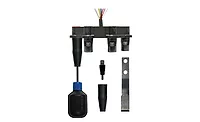Drillship JOIDES Resolution Arrives at Port
The drillship JOIDES Resolution ("JR") has
returned to international operations, and will make a port call in Honolulu,
Hawaii, May 5-9.
When it arrives, an international team of scientists studying seafloor sediments will have completed the first of two 9-week Integrated Ocean Drilling Program (IODP) expeditions to the equatorial Pacific Ocean.
After more than 2 years of rebuilding, the JR has new capabilities that include an upgraded sub-sea camera system, improved core-handling capability, and new core research stations and software, among others.
The National Science Foundation (NSF), the University of Hawaii at Manoa's School of Ocean & Earth Sciences & Technology (SOEST), and the Integrated Ocean Drilling Program-US Implementing Organization will welcome guests to the ship on Wednesday, May 6.
"The Resolution carries science teams whose research will help us better understand Earth's current climate and its ancient sea levels," says NSF Director Arden Bement, Jr. "This research will help resolve the puzzles of continental drift, volcano formation and the onset of earthquakes." During the first phase of IODP drilling operations from 2004-2006, 12 expeditions were conducted. Ten of those expeditions were conducted aboard the JR prior to its redesign. "Having twice sailed as an ocean drilling expedition co-chief scientist, I'm especially pleased to see the lab upgrades and return to operations of this amazing educational asset," says Brian Taylor, dean of SOEST.
IODP is an international marine research program dedicated to advancing scientific understanding of the Earth through drilling, coring and monitoring the subseafloor. The program operates three drilling platforms: Chikyu, a riser-equipped vessel provided by Japan; the JOIDES Resolution, the newly refurbished research vessel provided by the United States; and mission-specific drilling platforms, such as jack-up rigs similar to those that drill for oil in the Gulf of Mexico, managed by ECORD, the European Consortium for Ocean Research Drilling.
During the first week of May 2009, all three platforms will be conducting investigations.
The Chikyu will disembark from Shingu in Japan for the Nankai Trough Seismogenic Experiment (NanTroSEIZE), a multi-expedition drilling project focused on an earthquake-generating zone.
The JOIDES Resolution will continue the Pacific Equatorial Age Transect (PEAT) Expedition, sampling Pacific Ocean sediments and studying the transition from climates that existed 15 million to 50 million years ago to today's conditions. Scientists aboard the JR will investigate warm periods in Earth's history that share many features with the warm period Earth currently is entering.
ECORD, through its operator the British Geological Survey, will core continental shelf sediments off New Jersey to study changes in sea level from 14 million to 24 million years ago.
See the May 4 news article, ”Scientists Launch Drill Rig off New Jersey Shore,” for additional information on the ECORD project.
When it arrives, an international team of scientists studying seafloor sediments will have completed the first of two 9-week Integrated Ocean Drilling Program (IODP) expeditions to the equatorial Pacific Ocean.
After more than 2 years of rebuilding, the JR has new capabilities that include an upgraded sub-sea camera system, improved core-handling capability, and new core research stations and software, among others.
The National Science Foundation (NSF), the University of Hawaii at Manoa's School of Ocean & Earth Sciences & Technology (SOEST), and the Integrated Ocean Drilling Program-US Implementing Organization will welcome guests to the ship on Wednesday, May 6.
"The Resolution carries science teams whose research will help us better understand Earth's current climate and its ancient sea levels," says NSF Director Arden Bement, Jr. "This research will help resolve the puzzles of continental drift, volcano formation and the onset of earthquakes." During the first phase of IODP drilling operations from 2004-2006, 12 expeditions were conducted. Ten of those expeditions were conducted aboard the JR prior to its redesign. "Having twice sailed as an ocean drilling expedition co-chief scientist, I'm especially pleased to see the lab upgrades and return to operations of this amazing educational asset," says Brian Taylor, dean of SOEST.
IODP is an international marine research program dedicated to advancing scientific understanding of the Earth through drilling, coring and monitoring the subseafloor. The program operates three drilling platforms: Chikyu, a riser-equipped vessel provided by Japan; the JOIDES Resolution, the newly refurbished research vessel provided by the United States; and mission-specific drilling platforms, such as jack-up rigs similar to those that drill for oil in the Gulf of Mexico, managed by ECORD, the European Consortium for Ocean Research Drilling.
During the first week of May 2009, all three platforms will be conducting investigations.
The Chikyu will disembark from Shingu in Japan for the Nankai Trough Seismogenic Experiment (NanTroSEIZE), a multi-expedition drilling project focused on an earthquake-generating zone.
The JOIDES Resolution will continue the Pacific Equatorial Age Transect (PEAT) Expedition, sampling Pacific Ocean sediments and studying the transition from climates that existed 15 million to 50 million years ago to today's conditions. Scientists aboard the JR will investigate warm periods in Earth's history that share many features with the warm period Earth currently is entering.
ECORD, through its operator the British Geological Survey, will core continental shelf sediments off New Jersey to study changes in sea level from 14 million to 24 million years ago.
See the May 4 news article, ”Scientists Launch Drill Rig off New Jersey Shore,” for additional information on the ECORD project.
Looking for a reprint of this article?
From high-res PDFs to custom plaques, order your copy today!






